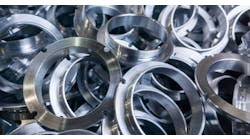Scanning CMMs measure production parts more accurately than touch trigger CMMs.
Scanning CMMs, as compared to touch trigger CMMs, provide more accurate results when measuring production parts.
Several tests prove that there is a direct link between the uncertainty for a test feature and the number of points measured.
Significant form measurement errors are evident when using only four sample points. A part measured with a touch trigger CMM would pass this inspection test with flying colors. However, a scanning CMM reveals the part's true form, which may be outside the acceptable tolerance range.
Alignment can be critical in GR&R. When an operator removes and replaces a part, he doesn't necessarily place it in the same position. This causes different measuring results — even when the operator is checking only four points. However, with scanning, even if the part is removed and replaced in a different position, the operator — or even several operators — obtain correct and repeatable results.
Accurately evaluating imperfect form, a standard procedure in the world of production parts, is demanding, particularly with parts becoming more complex and accuracies getting tighter. One way to get a more accurate measurement is to reduce measuring uncertainty, which is a calculated estimate of how much a measured result may vary from the true value. This number is based on factors such as operator influence and environmental conditions. By obtaining higher data density — perhaps acquiring 800 sampling points instead of eight — manufacturers can reduce measuring uncertainty. And the tools to use are high-speed scanning and robust mathematics.
Today's scanning probes read hundreds or thousands of points in the time it takes a CMM with a touch trigger probe (TTP) to check only four to eight points. For instance, a high-speed scanning probe can measure the entire diameter of a 143.8-mm bore in 11 sec, taking 831 measuring points. In another example, the 30-sec scan of a 52.8-mm, CNC-milled bore yields approximately 3,000 measuring points, all of which can be taken on the shop floor.
Of course, when the measurement involves a near perfect artifact, probe point quantities and locations are insignificant in calculating the result. In measuring production parts, however, CMMs inspect imperfectly formed features and then mathematically relate sampled points to geometric elements like circles, planes, and cylinders. Results vary according to where the CMM samples each feature. This means the quality of size, location, and form data is directly related to the number of samples and the location of each point.
The power is in the math
Although a lot of people use it, Least Squares (Gaussian) mathematics is not the most correct way to evaluate flatness, straightness, parallelism, and perpendicularity. In addition, it does not provide a functional size or location, nor does it evaluate form properly.
The contemporary solution for this problem is better mathematics. And fortunately, scanning methods enable the use of alternate algorithms, resulting in more accurate measurements.
For example, algorithms that compute maximum inscribed cylinders can provide significantly better assessments of the true values for size, location, and orientation when measuring a bore. Likewise, minimum zone computations provide better results for the form of a feature.
But if CMM manufacturers know that Least Squares mathematics is not the optimum method, why is it used? The answer is that the algorithms that are "more correct" require very high data density to produce stable and re-liable results. Least Squares is simply the best available solution for producing repeatable results when dealing with low data density.
High density and improved process control
In their role as process control gages, CMMs are evaluated with gage repeatability and reproducibility (GR&R) tests. A GR&R can be more difficult than simply identifying measurement uncertainty on traceable artifacts. This is because GR&R tests are conducted on production parts instead of traceable artifacts, which have near perfect form. Production parts, on the other hand, have form errors, affecting the sampling device's ability to generate the same answer when measuring multiple parts a number of times by several operators.
Once again, high data density is the solution. Sampling several hundred points significantly improves GR&R results by eliminating dependency on where the data is taken from one trial to the next.
In one GR&R test that compared a high data density scanning CMM to a low density TTP CMM, Zeiss measured an aluminum electric motor housing. The test checked 29 characteristics in a two-operator, three-trial study.
The high data density solution repeated approximately 2 as well as the low data density method, and reproducibility was approximately 10 better. The highest improvement in a measured characteristic was 75% for a projected true position. High data density also improved the results for five other characteristics by 20% or more. Overall, the improvement averaged 11%.





